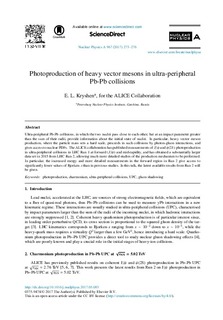Photoproduction of heavy vector mesons in ultra-peripheral Pb–Pb collisions
Acharya, Shreyasi; Adam, Jaroslav; Adamová, Dagmar; Adolfsson, Jonatan; Aggarwal, Madan M.; Aglieri Rinella, Gianluca; Agnello, Michelangelo; Agrawal, Nikita; Ahammed, Zubayer; Ahmad, Nazeer; Ahn, Sang Un; Alme, Johan; Altenkaemper, Lucas; Arsene, Ionut Christian; Bätzing, Paul Christoph; Djuvsland, Øystein; Dordic, Olja; Helstrup, Håvard; Hetland, Kristin Fanebust; Kileng, Bjarte; Langøy, Rune; Lardeux, Antoine Xavier; Lien, Jørgen; Lindal, Svein; Lønne, Per-Ivar; Mahmood, Sohail Musa; Milosevic, Jovan; Nesbø, Simon Voigt; Nystrand, Joakim; Rehman, Attiq ur; Richter, Matthias; Røed, Ketil; Røhrich, Dieter; Skaali, Toralf Bernhard; Tambave, Ganesh Jagannath; Tveter, Trine Spedstad; Ullaland, Kjetil; Velure, Arild; Wagner, Boris; Wikne, Jon Christopher; Zhang, Hui; Zhao, Chengxin; Zhou, Zhuo; Zhu, Hongsheng; Aiola, Salvatore; Akindinov, Alexander; Alam, Sk Noor; Alba, José Luis Bazo; Aleksandrov, Dimitry; Allesandro, B.; ALICE, Collaboration
Journal article, Peer reviewed
Published version
Permanent lenke
http://hdl.handle.net/11250/2499460Utgivelsesdato
2017Metadata
Vis full innførselSamlinger
- Institutt for mikrosystemer [522]
- Publikasjoner fra CRIStin [3416]
Sammendrag
Ultra-peripheral Pb-Pb collisions, in which the two nuclei pass close to each other, but at an impact parameter greater than the sum of their radii, provide information about the initial state of nuclei. In particular, heavy vector meson production, where the particle mass sets a hard scale, proceeds in such collisions by photon-gluon interactions, and gives access to nuclear PDFs. The ALICE collaboration has published measurements of J/ψ and ψ(2S) photoproduction in ultra-peripheral collisions in LHC Run 1 at forward (J/ψ) and mid-rapidity, and has obtained a substantially larger data set in 2015 from LHC Run 2, allowing much more detailed studies of the production mechanism to be performed. In particular, the increased energy and more detailed measurements in the forward region in Run 2 give access to significantly lower values of Bjorken-x than in previous studies. In this talk, the latest available results from Run 2 will be given.

